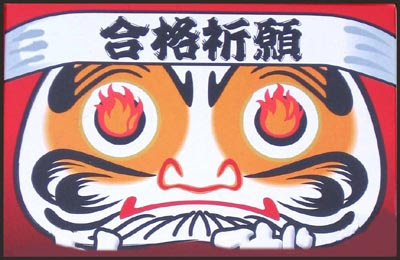[ . BACK to WORLDKIGO . TOP . ]
:::::::::::::::::::::::::::::::::::::::::::::::::::::::::::::::::::::::::::::::::::::::::::::::::::::
Tachibana ya
you never know
what's in a name
The
Tachibana, Fujiwara, Genji and Heike
are the four great clans of Old Japan.

Here is more, and even some ancient citrus fruit.
tachibana 橘 (たちばな) Tachibana citrus fruit
:::::::::::::::::::::::::::::::::::::::::::::::::::::::::::::::::::::::::::::::::::::::::::::::::::::
Matsuo Basho
橘やいつの野中の時鳥
tachibana ya itsu no nonaka no hototogisu
fragrant mandarin oranges -
when and in what field (do I hear)
the hototogisu
hototogisu 時鳥 lit. "bird of time"
The fragrant tachibana are associated with the fourth lunar month, while the lesser cuckoo belongs to the fifth lunar month of old waka poetry.
Basho draws on a waka
from the Kokin Wakashu 古今集, Summer 139
五月待つ 花橘 香をかげば
昔の人の 袖の香ぞする
satsuki matsu hanatachibana no ka o kageba
mukashi no hito no sode no ka zo suru
When I breathe in the scent
of the mandarin orange blossoms
that await the Fifth Month,
I recall the fragrance of the sleeves
of one I loved long ago.
Tr. David L. Barnhill
- Reference -

:::::::::::::::::::::::::::::::::::::::::::::::::::::::::::::::::::::::::::::::::::::::::::::::::::::

with a memorial stone at Kiyomizu temple, Otowa town, Shizukoa
静岡市音羽町 清水寺
駿河路や花橘も茶の匂ひ
Suruga ji ya hana tachibana mo cha no nioi
Suruga road -
Tachibana blossoms
smell of tea too
Tr. Gabi Greve
Written on the 15th day of the 5th lunar month.
元禄7年5月17日, Basho age 51
The region was and still is famous for its tea planations.
The fragrance of Tachibana is very strong, but the smell of tea blossoms is even stronger here.
Suruga province 駿河国 is the old name of the Shizuoka region.
The bay is Suruga Bay 駿河湾.
. Matsuo Basho 松尾芭蕉 - Archives of the WKD .
:::::::::::::::::::::::::::::::::::::::::::::::::::::::::::::::::::::::::::::::::::::::::::::::::::::
Suruga Province (駿河国, Suruga no kuni)
was an old province in the area that is today the central part of Shizuoka prefecture.
It was sometimes called Sunshū (駿州). Suruga bordered on Izu, Kai, Sagami, Shinano, and Tōtōmi provinces; and had access to the Pacific Ocean through Suruga Bay.
Suruga was one of the original provinces of Japan established in the Nara period under the Taihō Code. The original capital of the province was located in what is now
Numazu, which also had the Kokubun-ji and the Ichinomiya (
Mishima Taisha) of the province. Under the Engishiki classification system, Suruga was ranked as a "major country" (上国), and was governed by a Kuni no miyatsuko.

In a 680 AD cadastral reform, the districts forming Izu Province were administratively separated from Suruga, and the provincial capital was relocated to the right bank of the Abe River in what is now Shizuoka City.
Records of Suruga during the Heian period are sparse, but during the Kamakura period, Suruga was under direct control of the Hōjō clan, and with the development of the Kamakura Shogunate came increased traffic on the Tōkaidō road connecting Kamakura with Kyoto. The province came under the control of the Imagawa clan for much of the Sengoku period, and the Imagawa made efforts to introduce the customs and rituals of the kuge aristocracy to their capital. After Imagawa Yoshimoto was defeated by Oda Nobunaga at the Battle of Okehazama, the province taken by Takeda Shingen of Kai, and in turn by Tokugawa Ieyasu from Mikawa and Tōtōmi.
Toyotomi Hideyoshi forced the Tokugawa to exchange their domains for the provinces of the Kantō region, and reassigned Sunpu Castle to one of his retainers, Nakamura Kazuichi. However, after the defeat of the Toyotomi at the Battle of Sekigahara, Tokugawa Ieyasu recovered his former domains, and made Sunpu Castle his home after he formally retired from the position of Shōgun.
During the Edo period, Suruga prospered due to its location on the Tōkaidō, and numerous post towns developed. The Tokugawa Shogunate forbid the construction of bridges on the major rivers of Suruga Province (such as the Ōi River) for defensive purposes, which further led to town development on the major river crossings.
© More in the WIKIPEDIA !
:::::::::::::::::::::::::::::::::::::::::::::::::::::::::::::::::::::::::::::::::::::::::::::::::::::
tachibana 橘 (たちばな) Tachibana citrus fruit
. . . Read my Haiku Archives
[ . BACK to WORLDKIGO . TOP . ]
:::::::::::::::::::::::::::::::::::::::::::::::::::::::::::::::::::::::::::::::::::::::::::::::::::::

























